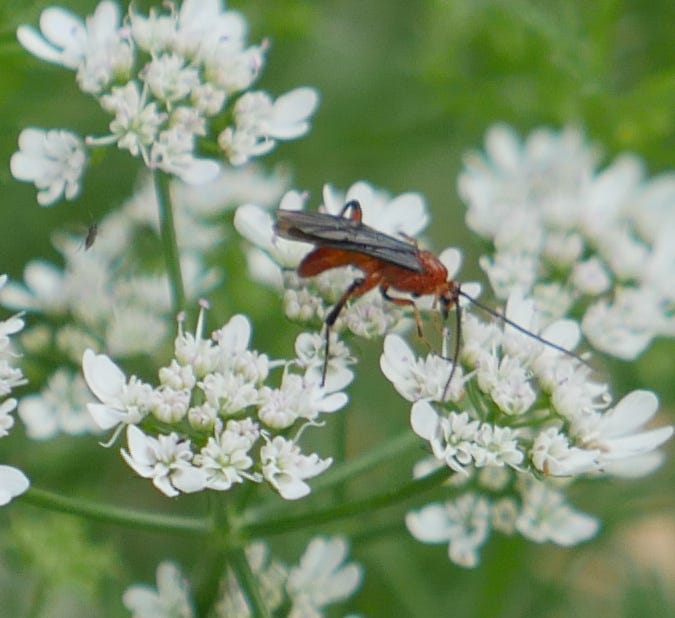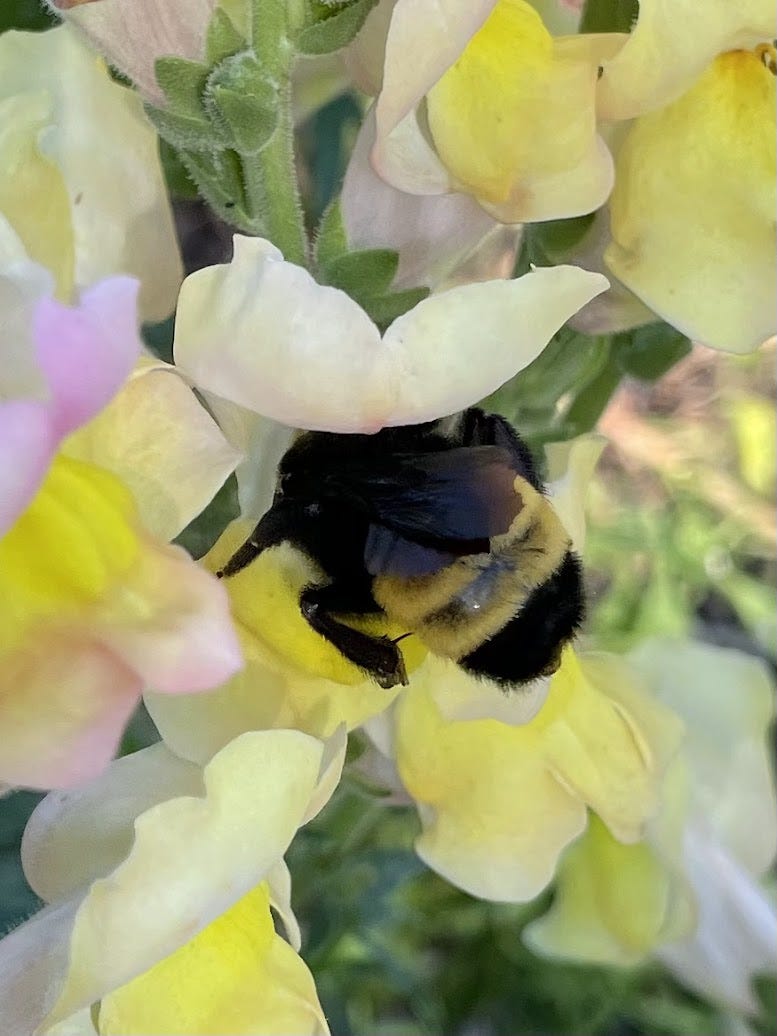#2 Pollinator news
Using Flowers to Create a Healthier Garden
“If, of thy mortal goods, thou art bereft,And from thy slender store two loavesalone to thee are left,Sell one and from the dole,Buy Hyacinths to feed the soul”– Muslihuddin Sadi,13th Century Persian Poet
Flowers are lovely and we love them! If your goal is to grow food they can seem like a luxury. Are they though? We find their beauty adds immeasurably to our enjoyment of the garden and that is enough reason to have them there, but there are also very practical reasons to include them in the mix as well.
I took the Pollinator course from Pollinator Partners a couple of years ago, something I highly recommend. It started me on my journey of documenting pollinators in my garden, and I found an entire universe amongst the flowers.
Now, I design my garden yield to allow for a certain percentage of plants in the garden to go to flower because of the pest predators and other native pollinators they support.
I stagger plantings to ensure pollinators will always have plenty of nectar in the garden.
And I ensure there are plenty of native and perennial flowers in my garden and food forest too.
This month, I’ll share some of my favorite pollinating garden plants and the kind of useful pollinators they attract.
The Carrot Family
These plants include some of our favorite foods like cilantro, dill, fennel, parsley, and of course, carrots. In Florida, they all tend to flower at different times, and we plant in three seasons so have these flowering during the major pest seasons.
Why are they good for pest controls? For one thing, they have a strong odor which confuses pests that depend on scent to find their food. This is why we tend to plant them amidst our other crops like broccoli and tomatoes.
They also have a unique tiny flower that allows pest predator wasps with very tiny proboscises to feed. Some of these wasps are so small they are hard to identify with the naked eye. Taking photos with a zoom lens is the most efficient way I’ve been able to ID them. These wasps are not aggressive at all, and some do not even have stingers.
We’ll share some of the most common that we see in the garden.
The Typhiid Flower Wasps family love tiny carrot family flowers. Their babies eat Japanese beetles and June beetles. They are sold as biological controls for pests, but you can bring them to your garden simply by planting small flowers in it.
The larvae of the very tiny wasp below eat cutworms and army worms.
Cute flies that eat pests
Many people don’t know that there are entire groups of quite attractive flies that specialize in eating the dreaded garden pests aphids, caterpillars and stink bugs. The adults sip nectar, and feed their young garden pests.
Syrphid flies tend to love aphids and some are sold as biological controls.
Tachnid flies tend to specialize in stink bugs. They are often sold as biological control agents, they’re so good at it.
This banded bee fly loves army worms.

These plants work well together because they all flower at different times (not to mention offering delicious, healthy fresh herbs to eat). Cilantro is first to bolt, flowering a couple of months after planting. Dill is next, flowering 2-4 weeks later. Parsley tends to follow, with carrots taking the longest to flower usually. Cilantro and dill flower in mid fall through spring in Florida, depending on when planted, bringing predators into the garden during peak season for many of them, where they nest nearby. In parts of Florida, both pests and predators live and breed year around with most action in spring and fall seasons. In my region, they rest for a couple of months in winter, but these carrot family plants live through our mild frosts. A second wave of cilantro and dill may flower in February, just when pest predators start to wake up and need food. Pests don’t show up in force until March or April, just in time to feed their hungry young with aphids, grubs, and grasshoppers.
By then, parsley, and sometimes carrots and fennel are flowering and continue to flower into June and sometimes later, especially if a second round of carrots is planted in March. Our gardens rest in summer, and by mid-fall, when we start planting veggies, cilantro is blooming again.
With this simple approach, our gardens have been kept pretty pest free.
Native carrot family plants are great too. If you’re in a temperate zone, Queen Anne’s Lace and Joe Pye weed are favorites of pest predators. Be careful, because the wild carrot family has some of the most delicious edibles, like Queen Anne’s Lace, but also some of the most deadly poisonous plants, like the dreaded Water Hemlock. So be sure you know how to tell the difference.
Feed the bees too!
We also love to place African basil, blue sage, snapdragons and cosmos in the gardens to bring in native bee pollinators. Native bees tend to love yellow or blue flowers. Bumblebees love our snapdragons and blue sage! We’ve caught them sleeping in snapdragon petals.
Native wildflower favorites of bees include most blue, purple or yellow flowers. The mint family and aster family are special favorites of many native bees.
Do:
Provide a fresh water source in the landscape
Provide pollinators throughout the season, including native pollinators (even a small patch of wildflowers can make a big difference)
Leave woody debris, brush piles, hollow stems, and open ground in the landscape (native pollinators nest in all of these)
Plant or preserve native trees (many are key pollinators during their season)
Do not:
Till your garden or landscape
Mow wildflowers before they set seed (including “weed” flowers)
Use any toxic chemicals in your landscape
Rake all your leaves, clean up all brush; leave some in the same areas each year!
We have grown to love and care for the pest predators and pollinators on our farm like we do the plants in our food forest. They perform vital ecosystem services and it’s worth providing them what they need (flowers are not a punishment!), in return.
Events and Courses
June 20, 1 PM
Come to Permaculture Institute North America’s free online town hall. We will be discussing the release of our Regenerative Disaster Management manuals on handling fire, hurricanes, and overall disasters. This townhall meets the third Friday of every month, with different speakers or interactive sessions on these topics. We have several more disaster manuals in the pipeline as well as other resources to offer. RSVP to get the zoom link here: https://pina.kit.com/townhall
Aug 18-23, evenings
Regenerative Disaster Summit
Koreen Brennan has been the coordinator for this project which will bring together information, experts and networks to ensure permaculture solutions are more broadly used in adaptation and resilience efforts. Hear from top permaculture experts on how to design for maximum resilience in disasters. Turn challenges into opportunities! We are in the process of putting together best practice resources for regenerative solutions to disaster, from around the world. Be a part of this movement! https://pina.kit.com/disastersummit
September
Learn how to heal the earth, grow more food with less effort, and get more fulfillment from your life.
Enrollment is open for our Permaculture Design Course starting in September. Join us in person in Florida for a life-changing experience. We will teach you how to build healthy, rich soil, design holistic systems, and regenerate your land without toxic chemicals. Early bird discounts are available so enroll now!
https://courses.growpermaculture.com/
Sept 20
We will have our first Grow Permaculture graduates convergence in Zephyrhills! This will be a potluck, starting mid-afternoon and go into the evening. Save the date and stay tuned for more info about times and location.
October
Our Online Permaculture Design Course is available worldwide! Learn at your own pace and from the convenience of your own home. Our online course covers the same comprehensive topics and includes hands-on assignments and online group meetings.
https://courses.growpermaculture.com/











